
Due to financial difficulties, the Peak Forest Canal Company was unable to proceed with the construction of Marple Locks. By as early as 1797, this was interfering with the company's trading capacity, so the Committee decided to bypass the unfinished locks with a single-track tramway. Work commenced on this in January 1798 and meanwhile the company was arranging for a loan from Richard Arkwright Junior of Cromford in order to complete the locks.
The construction of this tramway proceeded rapidly and it opened in May 1798, having a single track with passing places. This implies that the Lower Peak Forest Canal was then open for trade as far as the unfinished Marple Aqueduct. At the summit the tramway commenced at Brick Change Bridge and it terminated at Aqueduct Basin on the Lower Peak Forest Canal. The tramway would have crossed the river Goyt either on a temporary trestle bridge alongside the unfinished aqueduct or on an extension of the scaffolding being used for construction work on the aqueduct.
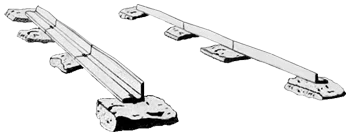 The Consultant Engineer for the construction of the Peak Forest Canal was Benjamin Outram and the cast-iron, L-section rails used in the construction of Marple Tramway were laid in accordance with his specifications.
The rails were supplied by Benjamin Outram & Company of Butterley, Derbyshire. They were one yard long, weighing about 56 pounds, and they were fastened directly onto stone sleeper blocks.
The blocks had a hole in the centre, into which was fitted an octagonal oak plug 5 inches long. The rails had a tapered notch or slot at each end and when two rails were butted together these formed a rectangular opening.
A wrought-iron spike, with a tapered-rectangular head, was then driven through the opening and into the plug, thus securing the rails to the block.
In cross-section, the rails were about 4 5/l6 inches wide, with a flange on the inner edge 3¾ inches high in the centre and 3 inches high at each end.
The rails were laid to a gauge of 4 feet 2 inches between the rail flanges.
The Consultant Engineer for the construction of the Peak Forest Canal was Benjamin Outram and the cast-iron, L-section rails used in the construction of Marple Tramway were laid in accordance with his specifications.
The rails were supplied by Benjamin Outram & Company of Butterley, Derbyshire. They were one yard long, weighing about 56 pounds, and they were fastened directly onto stone sleeper blocks.
The blocks had a hole in the centre, into which was fitted an octagonal oak plug 5 inches long. The rails had a tapered notch or slot at each end and when two rails were butted together these formed a rectangular opening.
A wrought-iron spike, with a tapered-rectangular head, was then driven through the opening and into the plug, thus securing the rails to the block.
In cross-section, the rails were about 4 5/l6 inches wide, with a flange on the inner edge 3¾ inches high in the centre and 3 inches high at each end.
The rails were laid to a gauge of 4 feet 2 inches between the rail flanges.
The method of operating the tramway is unknown. Loaded waggons descending the tramway could have travelled down some sections under the action of gravity and in other sections with the aid of a rope. One clue is that in 1801 a £50 reward was on offer to anyone who could give information about the rope being cut. Empty waggons travelling uphill could have been horse hauled in some places and in others by rope.
In 1798 it was recorded that a Mr Nixon was in charge of the tramway and in early 1801 a Mr Lloyd was appointed as the Superintendent. In May 1801 the Committee offered Thomas Brown, the Resident Engineer, £100 to move 800 tons of limestone in 18 hours. He moved 1,170 tons in the set time and he was presented with a £100 note.
By the turn of the 19th century, the demand for limestone and lime was increasing rapidly and as a result the Committee ordered the track at Marple to be doubled, the work being completed in Oct 1800.
On the 5 Nov 1805, James Meadows Sr was appointed as the Joint Principal Agent of the Ashton and Peak Forest Canals and one of his many duties was to inspect the Marple Tramway.
Marple Locks were eventually opened throughout in Nov 1805 but the tramway remained operational until Feb 1807. James Meadows Sr was ordered to dispose of the bulk of the tramway on the best terms he could get and in the event it seems that Samuel Oldknow was given permission to use the redundant rails and stone sleeper blocks to build a tramway on his estate at Hyde Bank for carrying sand and gravel down to the canal. The date of this work is uncertain except that it was between 1808 and 1811.
When the Peak Forest Tramway, Upper Peak Forest Canal and Marple Tramway were all operational in 1798, it was a very early example of containerisation being used for the bulk transport of cargo. Each waggon arriving at Bugsworth Basin from the limestone quarries at Dove holes would have its container, full of stone, detached from the chassis and hoisted into the hold of a boat. Once the boat was full, it proceeded to the wharf of the Marple Tramway adjacent to Brick Change Bridge. Here each container was hoisted out of the boat and placed on the chassis of a tramway waggon. When sufficient waggons were loaded, the gang proceeded down Marple Tramway to Aqueduct Basin where each container was detached from its waggon chassis and hoisted into the hold of a boat. Once the boat was full, it proceeded to its destination.
Route of Marple Tramway
There are no known records, plans or maps of Marple Tramway and archaeological remains of it are virtually non-existent. As a result of this, the exact route of the tramway is
unknown but, nevertheless, it has been possible to create a conjectural route for the tramway by a process of synthesis, (Map 1).
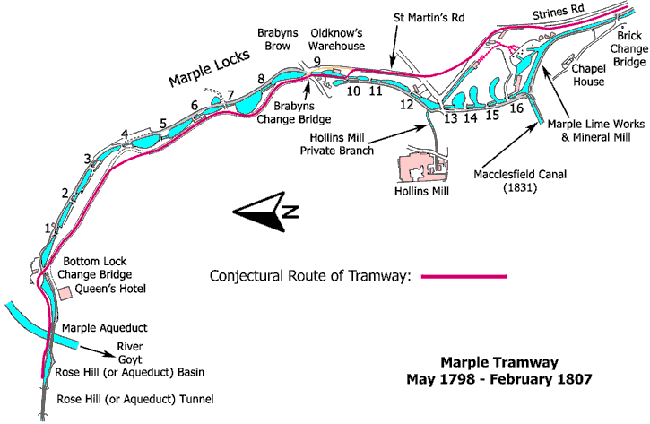
Map 1
At the summit of the tramway by the Upper Peak Forest Canal there was a waggon-loading wharf situated between Brick Change Bridge and Summit Warehouse, (Map 2). Later, this warehouse was converted into a corn mill, following which it became part of Marple Mineral Mill.
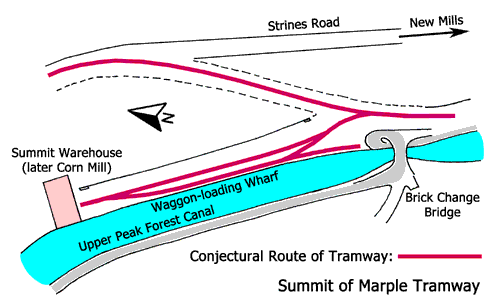
Map 2
Loaded waggons proceeded down Strines Rd, passing Marple Lime Works. There was complex of waggon sidings in the yard beneath the lime kilns and it is likely that these were connected to the Marple Tramway. Beyond the lime works, the track turned northwards, away from Strines Rd, to cross a field (now a recreation ground) on an embankment. The remains of this embankment are still extant. The tithe map of 1841 shows that the tramway embankment then formed the boundary between two fields. The smaller one to the west and closest to the locks was the 'Triangle Field and Plantation' occupied by Joseph Gee, while the larger one to the east was 'Foxlowe Meadow' occupied by George Swaine. Both fields were owned by Peter Arkwright of Cromford.
The tramway then crossed Oldknow Rd to enter St Martin's Rd. Part way down this, on the approach to lock 10 of Marple Locks, it turned off the road towards the tail of lock 10, (Map 3). The tail of this lock was specially extended to accommodate a tramway bridge crossing over it at a skew angle. Evidence of this bridge is still extant in the copingstones.
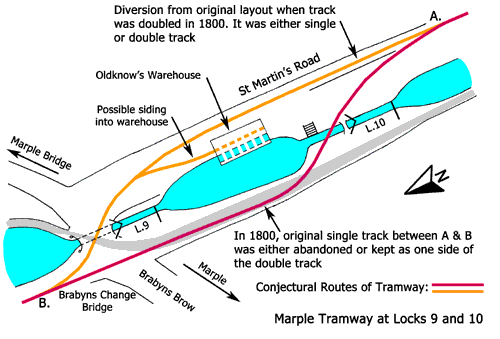
Map 3
After crossing the lock, the route followed the towpath for a very short distance until it reached Brabyns Change Bridge and lock 9. Here it crossed straight over Brabyns Brow to enter the track leading down to the Queen's Hotel, where Aqueduct Mills (Marple Chemical Company) were later built. It more-or-less followed the course of this track to pass Bottom Lock (lock 1) and reach the foot of the tramway but when it arrived at Bottom Lock Change Bridge it crossed back over the line of the canal to follow its offside as far as the river Goyt. There are two possible methods by which the river crossing was brought about. It was either on a temporary trestle bridge or on an extension of the scaffolding being used to construct Marple Aqueduct. On the other side of the river, the route was directly onto the offside of Aqueduct Basin where there was a waggon-unloading wharf (Map 4).
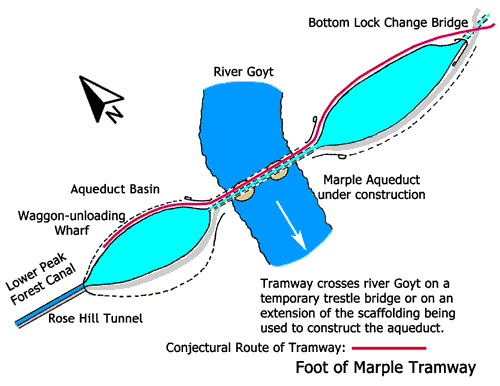
Map 4
Doubling the Track in 1800
It was a comparatively easy task to double the track, the only difficulty being the crossing at lock 10, which evidently remained single track.
There is always a possibility that this section remained single track but it is more likely the new track was routed further down St Martin's Rd (east side of Oldknow's Warehouse) to cross Marple Locks on
Brabyns Change Bridge.
It is also feasible that a siding was laid to the warehouse. This section of new track could have been either double or single. In the former case, the original crossing at lock 10 would have been abandoned
and in the latter case it would have been retained.
It is considered that the single track crossing of the river Goyt would not have been doubled but there is a possibility that a new track might have been laid on the towpath side of Aqueduct Basin to create a second waggon-unloading wharf to handle the increasing quantities of stone being transported.